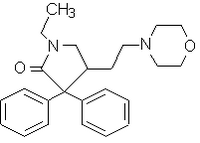Dopram
Doxapram hydrochloride (marketed as Dopram®) is an analeptic agent (a stimulant of the central nervous system). Administered intravenously, doxapram stimulates the respiratory rate, leading to an increase in tidal volume. more...
Mode of action
Doxapram stimulates chemoreceptors in the carotid arteries. This stimulates, indirectly, the respiratory centre in the brain stem.
Presentation
Doxapram is a white to off-white, odorless, crystalline powder that is stable in light and air. It is soluble in water, sparingly soluble in alcohol and practically insolible in ether. Injectable products have a pH from 3.5-5. Benzyl alcohol or chlorobutanol is added as a preservative agent in the commercially available injections.
Uses
Doxapram is used in intensive care settings to stimulate the respiratory rate in patients with respiratory failure.
It is equally effective as pethidine in suppressing shivering after surgery (Singh et al 1993).
Side effects
High blood pressure, tachycardia (rapid heart rate), tremor, sweating and vomiting may occur. Convulsions have been reported. It cannot be used in patients with coronary heart disease, epilepsy and high blood pressure. It is also contraindicated in newborns and small children, mainly due to the presence of benzyl alcohol.
Read more at Wikipedia.org



